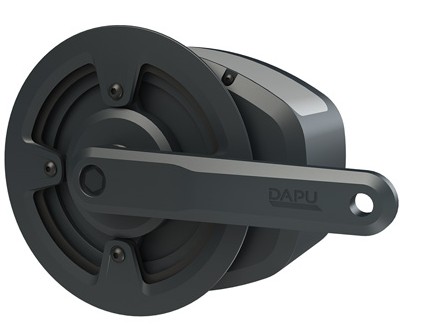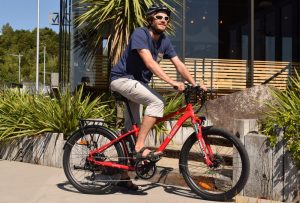Comparing a hub-drive and mid-drive electric bike? You’ll want to consider power, performance, and price. Because when it comes down to it, these are the differences that really matter.
How your electric bike is propelled has a significant impact on its ability to climb hills, on how it feels to ride (what we’re calling performance), and on how much it costs. Here is what you should consider.
Hub-drive vs. Mid-drive: Power
A hub-drive electric bike motor (sometimes called simply a hub motor) is situated in a bike’s hub — thus its name.
Front Hub motor
There are still a few models on the market with a front hub motor – we strongly advise not to consider these bikes. Having the motor in the front wheel has several negative effects on your cycling safety. First of all any suspension fork is pretty much useless as the stanchions get pulled out rather than compressed when riding over a bump, forks are actually not build for this purpose and can get damaged. By pulling the wheel, especially up a hill, steering feels unnatural, the additional weight of the front wheel makes it even more awkward. And lastly a pulling front wheel will start to slip when going up hill or around corners on gravel or wet surface since it will loose traction. Remember that the front wheel compared to the rear wheel has much less weight on the road. This can and has led to serious accidents.
Rear Hub Motor
A rear hub motor “pushes” the bike forward, spinning the wheel in accordance with a controller and a cadence or torque sensor.
Mid-Drive Motor
 In contrast, mid-drive motors power the bike’s drive-train directly at the crank set. So, a mid-drive motor will work in tight coordination with the bike’s gears, amplifying the mechanical advantage they provide. This becomes particularly helpful for climbing steep hills or navigating extended inclines. On these types of terrain, mid-drive motors can leverage the gears and keep the bike’s revolutions per minute (RPMs) in an efficient range without getting bogged down.
In contrast, mid-drive motors power the bike’s drive-train directly at the crank set. So, a mid-drive motor will work in tight coordination with the bike’s gears, amplifying the mechanical advantage they provide. This becomes particularly helpful for climbing steep hills or navigating extended inclines. On these types of terrain, mid-drive motors can leverage the gears and keep the bike’s revolutions per minute (RPMs) in an efficient range without getting bogged down.
The mid-drive motor on this electric bike works with the bicycle’s gears to propel the e-bike forward in a natural and powerful way.
Know your gears
This implies that the rider has to know how to change the gears according to the conditions he/she wants to ride in. Changing the gears puts also more strain on the drive-train and therefore it is important to make sure that the ebike you are looking at has a gear shift sensor. This means when the rider touches the gear shifter to change the gear, the motor will either reduce it’s torque or turn off entirely for a short moment. With reduced torque the chance of damaging the gears will be much lower. We won’t recommend a mid-drive ebike if the rider has no idea of how to use the correct gear and also does not want to be bothered with learning it – they won’t have a lot of fun and even might struggle to get up a hill, trying to use a much to high gear.
The Torque Machine
Given two electric motors of the same wattage, 300W continuous as an example, the mid-drive electric bike motor will likely provide more torque and more power than the hub-drive electric bike motor will.
Hub-drive vs. Mid-drive: Performance
For our context, we are going to describe e-bike performance as how it feels to ride.
Hub-drive electric bike motors feel like they have a lot of pep or liveliness. While this is not an indication of actual performance, the sensation is real. In this way, they are similar to a rear-wheel drive car or, as some riders have said, riding a Bird or Lime electric scooter. Frankly, the ride can be fun or even thrilling. That’s a big plus for hub-drive motors.

A hub-drive electric bike can be a fun, value-priced option.
Mid-drive electric bikes feel like bicycles. The power that the motor provides is channeled through the bike’s drive-train, so a rider might not notice the power as much as he or she would on a hub-drive e-bike. Instead, a mid-drive bike will simply go fast and climb hills with ease. It is also worth noting that a mid-drive motor tends to “ramp up” more smoothly, giving it a natural feel and protecting the bike’s drive-train.
Mid-drive motors position all of the additional weight at the center of the bike, so they can feel more balanced than a hub-drive e-bike will.
Hub-drive vs. Mid-drive: Price
Hub-drive electric bikes cost significantly less than mid-drive electric bikes. There are a number of reasons for this, including design, manufacturability, and the technology itself.
For example, a hub-drive motor can be added to just about any bicycle frame while a mid-drive motor must be integrated, so the frame is always custom designed for that particular motor. What’s more, mid-drive motors are a newer technology which can make them more expensive than a hub-drive motor.
Beware of “cheap” mid drive offers – there are new brands pushing on the market using mid-drive motors not always suitable for purpose. These cheap options (i.e. Shimano E5000) have been designed for city usage in mostly flat environments like the Netherlands. To use this kind of a motor in a mountain bike won’t give the rider the experience they are looking for.
Hub-drive vs. Mid-drive: Reliability
There are a lot of discussions about which system is actually more reliable in the long term run.
There are meanwhile bike shops telling customers that a hub motor is prune to break because of it’s internal gears and possible damage due to water or dust. This it not more true than it does apply in the same way to any mid-drive motor system.
Since a mid drive motor basically uses also an even smaller motor and more gears there is no reason why these motors will be in the long run more or less reliable than a traditional hub motor. The only difference for the customer will be the quality and cost of any after sales repairs, which are typically lower for a hub motor system.
More sophisticated mid-drive system might even need parts from overseas, which means that your bike might be out of order for weeks or even months.
A second issue with mid-drive systems is the higher wear-and-tear on the drive train. Due to much higher forces (motor + rider), the chain and cluster (the cogs at the back) will wear out much faster than on a hub-drive e-bike. The chain, even being reinforced, will stretch causing it to jump. The tips of the rear cogs will get damaged over time, when changing gears, especially under load. So be prepared that the maintenance cost of a mid-drive system is significantly higher.
Hub-drive vs. Mid-drive: You Decide
Like so many things, choosing between a hub-drive and mid-drive electric bike requires you to weigh the options and pick the best one for your particular riding situation.
For example, if you live in an area with many hills or if you are a heavier rider, you might want to pay a bit more for a mid-drive e-bike’s superior climbing ability. If you are in area with average steep hills and don’t want to go on grade 4 tracks why not save a some money and get the fun-to-ride hub-drive. If your main focus is commuting, your are better off with a hub-drive since you won’t have the wear and tear issues, especially when riding most of the time in high gears.
